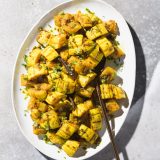Seeking an alternative to the cloying and butter-laden winter squash dishes that so often crowd holiday tables in the U.S., we turned to northern India, where a dry curry called kaddu ki sabzi transforms similar vegetables with bold spices.
Unlike the saucy Indian curries with which Americans tend to be more familiar, dry curries frequently call for just a small amount of liquid that mostly cooks off by the time the dish is finished. That process results in vegetables that are generously coated—almost glazed—with seasonings that concentrate as they cook down.
Traditionally, kaddu ki sabzi is made with Indian pumpkins (which have denser flesh and a slightly nuttier taste than their American siblings). This dish balances—but also heightens—their natural sweetness with a vibrant combination of pungent mustard, citrusy coriander, earthy cumin and turmeric, grassy fennel and maple-y fenugreek.
Meanwhile, chilies add a pop of heat, and a bit of jaggery, or unrefined sugar, rounds out the sweetness with smoky depth. Amchoor, a tart powder made from unripe green mangos, provides a bright counterpoint.
“It was one of those perfect bites you remember for a lifetime,” says “Vibrant India” author Chitra Agrawal, recalling her first time trying her great aunt’s kaddu ki sabzi.
We realized that slightly sweeter American winter squash also could benefit from this treatment, particularly acorn and delicata squash. Like Indian pumpkins, both have smooth flesh, a thin, edible skin, and a rich, chestnutty taste.
To amplify our dry curry, we rely on the classic South Asian method of blooming fragrant ingredients in hot oil, which helps release fat-soluble flavor compounds. We also flavor our cooking liquid, adding ground turmeric, coriander and cayenne, as well as brown sugar, the caramel notes of which make it a good substitute for the traditional—but harder to source in the U.S.—jaggery.
And to replicate the tangy brightness of amchoor, also not easily found in most U.S. grocery stores, we turn to lemon juice.
The resulting squash boasts a tender interior and a wonderfully rich coating of seasonings.
Dry Curried Winter Squash
Bolstered by vibrant spices, this dry curry delivers deeply flavorful squash.
Photo: Connie Miller of CB Creatives; Styling: Monica Mariano






